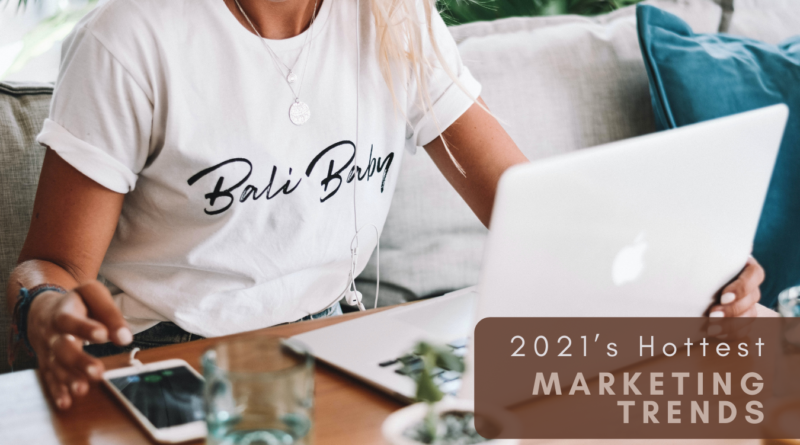2021’s Hottest Marketing Trends
A lot has changed in the online world after the global pandemic in 2020. With physical stores and services fading into insignificance, business owners, digital marketers, UX\UI designers, and developers all had to make a big step towards the optimization of their sites and business processes. We’ve seen a lot of new technologies, targeted approaches, fast progressive web applications, and change adoption in general.
But what are the current trends? On this page, we’ll introduce you to the 5 hottest ones in digital marketing in 2021.
1. Social Media Widgets
The first digital marketing trend worth noting regards interlinking social media content with your main website. Social media presence is getting more and more important for any business. This is a powerful channel for connecting with your audience. So why not enhance this connection on your site too?
As the number of your followers grows, your accounts on socials can receive plenty of high-quality user-generated content. This not only includes textual feedback and testimonials but also various photos and videos that mention your official account, site, or brand.
Therefore, one of the ways to use this valuable content to the most is having it up on your site apart from your social media pages. How is this done? By linking up a widget that would automatically pull posts to your site’s pages. Mind that the extension and plugin that’s responsible for this may vary depending on the platform that your site is run on.
When having a widget of such, you enrich your site content and raise trust. After all, this is great proof that real clients share about their experience working with you, your services, products, and how they’re used. Plus, you can give your existing customers the opportunity to express themselves, and for sure many of them will be happy to get featured on your site and get additional post views.
To provide you with an example, this is what such a section looks like on the official NYX Cosmetics website. As you can see, the brand inspires customers to make posts wearing the makeup and then collects the looks in a gallery of pictures that were made by users.
Screenshot taken on the official NYX Cosmetics website
2. Ads & Banners Created Using Graphic Design
The second recent trend in digital marketing revolves around the use of animation and graphic design. Regular static banners and content are quickly becoming replaced with eye-catching moving content. This includes both site content and the one put up on social channels.
On the whole, animation marketing is accelerating, and it’s pretty tough to deny how effective it is. Be it used for explainer purposes, “how-tos”, tutorials, advertisements, or anything else, graphic content is easier for a human to process than text. According to a 2020 post by Y. Polyashko:
“The complex data that’s offered in infographics looks merely more amusing and interesting in a short animation video or even a gif. It is a lot likelier to motivate a client to perform a targeted action.”
Take a look at the screenshot below of a category page that was taken on the official Converse website. One of the product slots is used for placing ads. This ad isn’t an image banner, it’s a simple yet clickable GIF animation that immediately attracts attention due to its moving elements.
Screenshot taken on the official Converse website
3. Putting Things on Virtually
Third on the list of marketing trends is virtual try-on functionality. This technology is still on hype, and an increasing number of merchants are boosting their sites with this feature. What any marketer should understand is that no matter how well you do at, say, describing the product’s color or texture, it will be much more effective to give your potential buyer the chance to visualize it.
That said, with the use of augmented reality, the camera of the user’s device becomes a “mirror” or means of real-time visualization. Products can be “applied” or “put on” (similarly to how beautification masks are used in social media). Without a doubt, this leads to a leap in conversions since shoppers don’t have to order things “blindly” anymore.
As you might have guessed, this tool has become a real lifesaver during the COVID pandemic in 2020 when most physical stores were closed or had limited entrance. Many retail spheres have already gained from providing virtual try-on experiences, including those specializing in the home furniture, apparel, accessories, and makeup.
For instance, the official NARS Cosmetics website is fitted with an AR-powered tool called “Match Maker”. It gives users the ability to test shades of foundations to match their skin tone. Fair enough, there may be some slight incongruity due to the individual camera specifics, yet the tool is quite accurate in color reproduction.
Screenshot taken on the official NARS Cosmetics website
4. Item Customizers
The next trend in marketing that made this overview is product builder functionality. Any marketer should comprehend the importance of an individual approach to clients. For this reason, providing the needed grounds for modifying the sold goods is a neat way to convert more buyers.
Product constructors allow changes to the item and thus sway away from the necessity of purchasing “off-the-rack”. This functionality brings out the customer’s creativity and helps to create truly unique styles. Yes, a customized product may come at a higher price, yet a big percentage of prospects are ready to pay a little extra for obtaining something exclusive.
An example of how such a tool is like is the product customizer that’s present on the official Nike website. With this tool, the client can “build their own” shoe design, changing the color, material, and other details of various shoe elements.
Screenshot taken on the official Nike website
5. Turning to the Influencers
Finally, we cannot but mention the role of influencers and brand ambassadors among the current digital marketing trends.
From celebrity endorsement to partnerships with influencers on social media or opinion leaders in the niche, such marketing may be expensive but generally pays off quickly. The main question here is choosing the right candidate for your audience. Based on the data provided by the Influencer Marketing Hub:
“Businesses are making $5.20 for every $1 spent on influencer marketing”
When an authoritative figure speaks in favor of your brand or represents your products, this can surely help to build trust. Not to mention that you can get new users only thanks to your brand getting attention because of an influencer who has a plethora of fans and followers.
To provide an example, below is a screenshot of a clothing collection on the official Puma website. These products are worn by Winnie Harlow, a renowned fashion model who is one of Puma’s brand representatives.
Screenshot taken on the official Puma website
To Sum Up
Wrapping up, numerous strategies and tools are currently trending in digital marketing. Among them are interlinking social media content using widgets, implementing virtual try on, and offering product personalization via product constructors. Furthermore, the use of animation and graphics in ads and site content, as well as partnerships with influencers, are among the recent trends used apart from the marketing classics!


